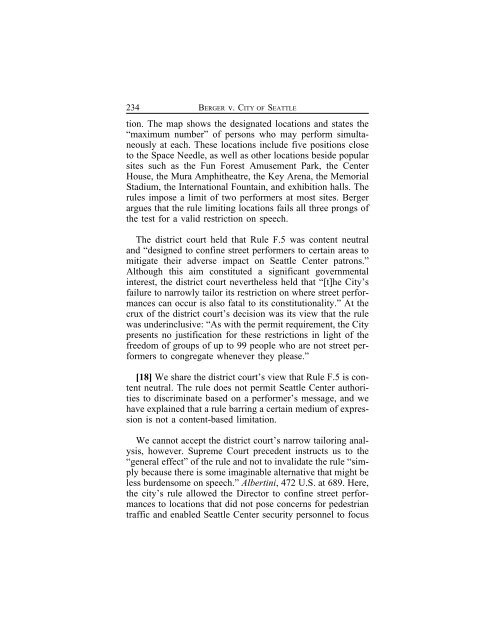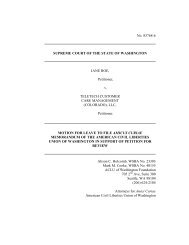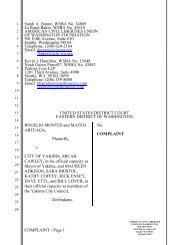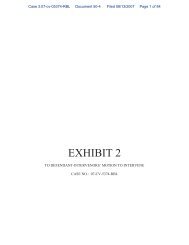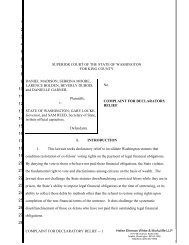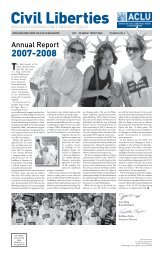BERGER v. CITY OF SEATTLE - ACLU of Washington
BERGER v. CITY OF SEATTLE - ACLU of Washington
BERGER v. CITY OF SEATTLE - ACLU of Washington
You also want an ePaper? Increase the reach of your titles
YUMPU automatically turns print PDFs into web optimized ePapers that Google loves.
234 <strong>BERGER</strong> v. <strong>CITY</strong> <strong>OF</strong> <strong>SEATTLE</strong><br />
tion. The map shows the designated locations and states the<br />
“maximum number” <strong>of</strong> persons who may perform simultaneously<br />
at each. These locations include five positions close<br />
to the Space Needle, as well as other locations beside popular<br />
sites such as the Fun Forest Amusement Park, the Center<br />
House, the Mura Amphitheatre, the Key Arena, the Memorial<br />
Stadium, the International Fountain, and exhibition halls. The<br />
rules impose a limit <strong>of</strong> two performers at most sites. Berger<br />
argues that the rule limiting locations fails all three prongs <strong>of</strong><br />
the test for a valid restriction on speech.<br />
The district court held that Rule F.5 was content neutral<br />
and “designed to confine street performers to certain areas to<br />
mitigate their adverse impact on Seattle Center patrons.”<br />
Although this aim constituted a significant governmental<br />
interest, the district court nevertheless held that “[t]he City’s<br />
failure to narrowly tailor its restriction on where street performances<br />
can occur is also fatal to its constitutionality.” At the<br />
crux <strong>of</strong> the district court’s decision was its view that the rule<br />
was underinclusive: “As with the permit requirement, the City<br />
presents no justification for these restrictions in light <strong>of</strong> the<br />
freedom <strong>of</strong> groups <strong>of</strong> up to 99 people who are not street performers<br />
to congregate whenever they please.”<br />
[18] We share the district court’s view that Rule F.5 is content<br />
neutral. The rule does not permit Seattle Center authorities<br />
to discriminate based on a performer’s message, and we<br />
have explained that a rule barring a certain medium <strong>of</strong> expression<br />
is not a content-based limitation.<br />
We cannot accept the district court’s narrow tailoring analysis,<br />
however. Supreme Court precedent instructs us to the<br />
“general effect” <strong>of</strong> the rule and not to invalidate the rule “simply<br />
because there is some imaginable alternative that might be<br />
less burdensome on speech.” Albertini, 472 U.S. at 689. Here,<br />
the city’s rule allowed the Director to confine street performances<br />
to locations that did not pose concerns for pedestrian<br />
traffic and enabled Seattle Center security personnel to focus


